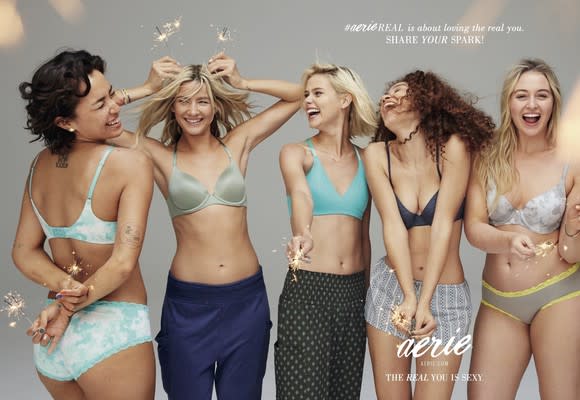3 Apparel Retailers With Hidden Growth Brands
Over the past few years, traditional apparel retailers have had to grapple with online competition and challenges from fast fashion chains like Zara. A long list of major chains -- including Aeropostale, American Apparel, Wet Seal, and The Limited -- have filed for bankruptcy, supporting the bearish notion that mall-based retailers' days are numbered.
However, many companies that survived the purge have come out stronger with market share gained from their fallen rivals. They also shrank their footprint, expanded online and overseas businesses, and invested more heavily in growing secondary brands.

Image source: Getty Images.
Over time, several of these secondary brands have become core growth drivers for their parent companies, offsetting the weaker results of the rest of the business. Let's look at three rising stars that fit that description -- American Eagles' (NYSE: AEO) Aerie, Abercrombie & Fitch's (NYSE: ANF) Hollister, and Gap's (NYSE: GPS) Athleta.
AEO's Aerie
Aerie, which was founded in 2006, sells lingerie, loungewear, and activewear to teens and young women. Aerie made a mark as the "anti-Victoria's Secret" with its untouched "body positive" ads featuring models of all shapes and sizes. It repeatedly promoted that image via social media campaigns with its #AerieREAL hashtag. Aerie is a much smaller brand than AEO, but its comparable sales growth has been robust over the past year.
Q1 2017 | Q2 2017 | Q3 2017 | Q4 2017 | |
American Eagle | (1%) | 0% | 1% | 5% |
Aerie | 25% | 26% | 19% | 34% |
Total | (1%) | 2% | 3% | 8% |
Comps growth by brand. Source: AEO quarterly reports.
At the end of fiscal 2017, AEO operated 933 namesake stores and 109 Aerie stand-alone locations. Aerie apparel is also available online and at pop-up locations in certain AEO stores.
During the most recent conference call, Aerie president Jen Foyle stated that AEO will open 35 to 40 new Aerie stores this year, with "roughly 70%" of those openings taking place in "underpenetrated markets". Foyle noted that "only 50% of women who shop our AE brand shop Aerie", which represents a major growth opportunity for the brand.

Image source: Aerie.
A&F's Hollister
A&F founded Hollister in 2000 as a casual "SoCal-inspired" apparel brand for teenagers. A&F then fabricated a history for the new brand, claiming that the fictional "John Hollister, Sr." -- upon returning to the U.S. from the Dutch East Indies -- founded the company in 1922.
Despite its absurd beginnings, Hollister eventually eclipsed A&F's namesake brand in terms of total revenue and comps growth. CEO Fran Horowitz-Bonadies, who took over in early 2017, had A&F invest heavily in Hollister's growth with fresh styles, store renovations, and new marketing campaigns. Those efforts clearly paid off over the past year.
Q1 2017 | Q2 2017 | Q3 2017 | Q4 2017 | |
Hollister | 3% | 5% | 8% | 11% |
A&F | (10%) | (7%) | (2%) | 5% |
Total | (3%) | (1%) | 4% | 9% |
Comps growth by brand. Source: A&F quarterly reports.
A&F finished fiscal 2017 with 538 Hollister stores and 330 Abercrombie stores. Hollister generated 58% of the company's revenue for the year. Recently, Horowitz-Bonadies stated that "Hollister started its revitalization journey" and "continues to build momentum and take market share."
Gap's Athleta
Gap's three core brands -- Old Navy, Gap, and Banana Republic -- traditionally fared well during both economic booms and busts. The low-end Old Navy held up during economic downturns; the pricier Banana Republic flourished during more prosperous times; and the mid-range Gap served as an all-weather brand.

Image source: Athleta.
However, all three brands were hurt by the increased competition and tough retail environment in recent years. This forced Gap to diversify into higher-growth niche markets like athleisure apparel, which was popularized by Lululemon.
Gap's play on this market is Athleta, a premium lifestyle and active-wear brand which was founded in 1998. Gap acquired the online-only retailer in 2008 and eventually expanded it into a brick-and-mortar operation to challenge Lululemon.
Gap doesn't yet disclose Athleta's exact sales growth, which is included with its namesake brand. But during last quarter's conference call, CEO Art Peck stated that Athleta's "performance to the year was extraordinary" and that it "moved from mid-teens sales growth in the first half of 2017 to mid-20s in the back half of the year." Gap opened 16 new Athleta stores last year, bringing its total store count to 148. That represents just 5% of its company-owned stores and indicates that the brand has plenty of room to grow.
The bottom line
Investors should always recognize and take note of an apparel company's entire portfolio. Their namesake brands might not seem impressive, but promising secondary brands like Aerie, Hollister, and Athleta could provide a much-needed tailwind to their parent companies.
More From The Motley Fool
Leo Sun owns shares of American Eagle Outfitters. The Motley Fool recommends Lululemon Athletica. The Motley Fool has a disclosure policy.

 Yahoo Finance
Yahoo Finance 